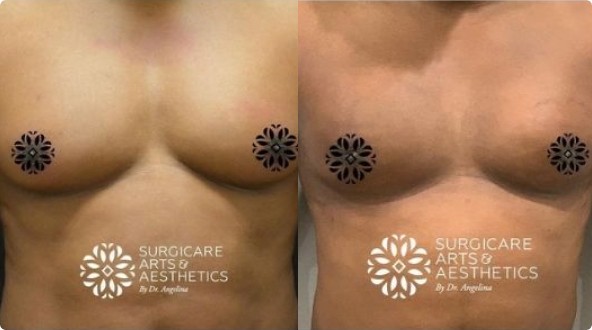Gynecomastia is a condition when a male’s breasts get bigger than usual, causing a man to feel uncomfortable with his body. It can happen to any male of any age, though more often a young boy or an older man experiences this sort of condition.
According to rough calculations, in the course of life, around 60% of men have to cope with a certain level of gynecomastia to some extent. Those who develop this condition are often curious about the question, “How long does gynecomastia last?”. There is no simple answer to this question since there are many factors that can influence it. Below we will discuss what causes gynecomastia, how it can be treated, and how long the condition usually lasts.
Causes of Gynecomastia
Some of the factors that can lead to gynecomastia are:
- Hormonal imbalances;
- Health disorders;
- Specific medications;
Gynecomastia happens when a male’s body starts producing more estrogen than testosterone which is called the female and male hormones respectively. During adolescence, when young boys start developing sexual maturity, for some time they can have high levels of estrogen which can give rise to gynecomastia. When it comes to older men, as they age they see a decrease in testosterone levels which can be accompanied by rising levels of estrogen in their body.
How Long Does Gynecomastia Last?
The duration of gynecomastia can vary depending on the underlying cause and the treatment options chosen.
How Long Does Gynecomastia Last In Puberty?
In cases where gynecomastia is caused by hormonal changes during puberty, the condition typically resolves on its own within six months to two years.
How Long Does Gynecomastia Last In Adults Or Older Men?
In older men or cases where gynecomastia is caused by medications or medical conditions, the duration may be longer. Treatment with medication or surgery may be necessary to resolve the condition.
It is important to note that gynecomastia can have a significant impact on self-esteem and quality of life. Seeking medical advice and treatment options can help alleviate discomfort and improve quality of life.
Treatment Options for Gynecomastia
Nowadays gynecomastia can be treated in several different ways depending on its cause and how severe the condition is.
Observation and Monitoring
Sometimes gynecomastia can go away by itself even if you don’t treat it. If young boys experience the condition, it is usually self-limiting and only lasts for a short term. In this and other situations, your doctor might just monitor and observe the disorder. The doctor will keep an eye on the condition, assess it, and recommend necessary measurements for management if there is a need for that.
Medications
Medications are one of the ways to get rid of gynecomastia. Some of the pharmacological treatments include selective estrogen receptor modulators (SERMs) and aromatase inhibitors.
Tamoxifen and raloxifene are representatives of SERMs that solve the issue by obstructing the impact of estrogen on breast tissue and aiding in making its volume smaller.
Anastrozole and other aromatase inhibitors do their job by stopping the enzyme from making estrogen out of testosterone. Normally, they are used for patients with moderate-to-severe gynecomastia or for those who struggled with this condition for at least a year. However, these drugs might not solve the issue for every patient and might not work in the long term. Yet, there is a list of side effects like nausea, muscle cramps, and hot flashes.
Cosmetic Procedures
Cosmetic surgery and non-surgical procedures become a good option when patients try all other methods and nothing works for them.
- Fatty gynecomastia also known as pseudo-gynecomastia can be treated with liposuction after which excessive fat tissue is removed. The liposuction procedure takes out undesired fat from the breast with the help of a suction device via a tiny incision. This type of treatment involves minimum scarring, and the shortest recovery time and is commonly advised for those who have mild to moderate cases of gynecomastia.
- Gynecomastia surgery involves removing the breast tissue through a larger incision. This procedure is typically recommended for patients with severe gynecomastia or those who have excess skin in addition to breast tissue. It can have a longer recovery time and more significant scarring.
- BodyTite is a non-surgical body contouring procedure that uses RD energy to address mild gynecomastia.

Lifestyle Changes
Making lifestyle changes such as losing weight, avoiding alcohol and drugs, and exercising regularly may help reduce the symptoms of gynecomastia. These changes may not be effective for all patients, especially in cases where the condition is caused by hormonal imbalances or medication use.
Supportive Garments
While not a true treatment for gynecomastia, compression garments or vests can help compress the breast tissue and reduce the appearance of gynecomastia. These garments are typically recommended for patients with mild to moderate gynecomastia and can be worn under clothing.
Gynecomastia can have a significant impact on a man’s self-esteem and quality of life. IBI Plastic Surgery & Med Spa can help you get rid of gynecomastia and restore your masculine-looking chest.
Through a combination of gynecomastia surgery and non-surgical procedures, the excess breast tissue can be removed, and the surface of the chest can be tightened and toned to appear more muscular and defined. Never feel self-conscious in a bathing suit or tighter-fitting shirt again! Set up a consultation to learn about your options for eliminating gynecomastia.







